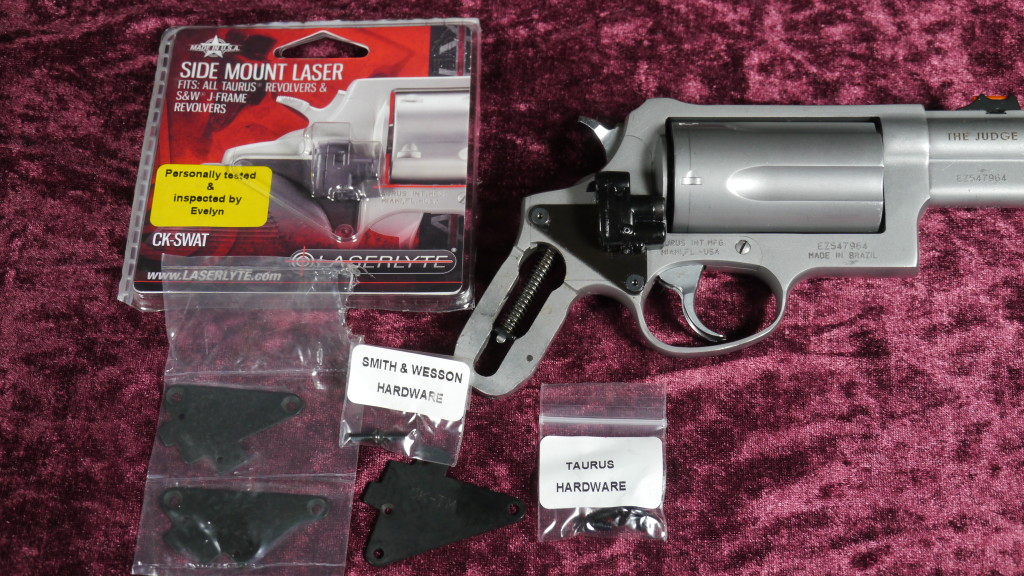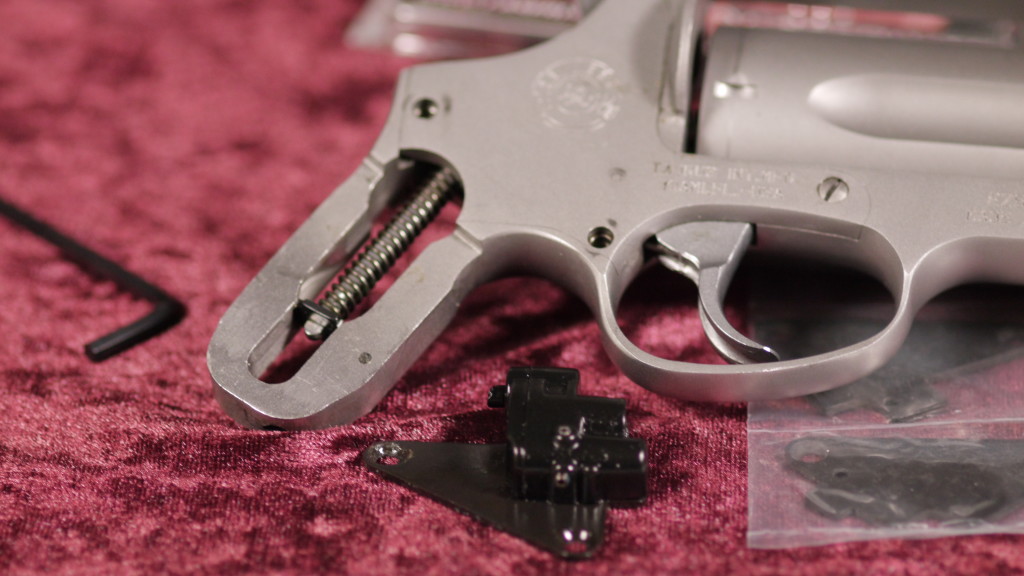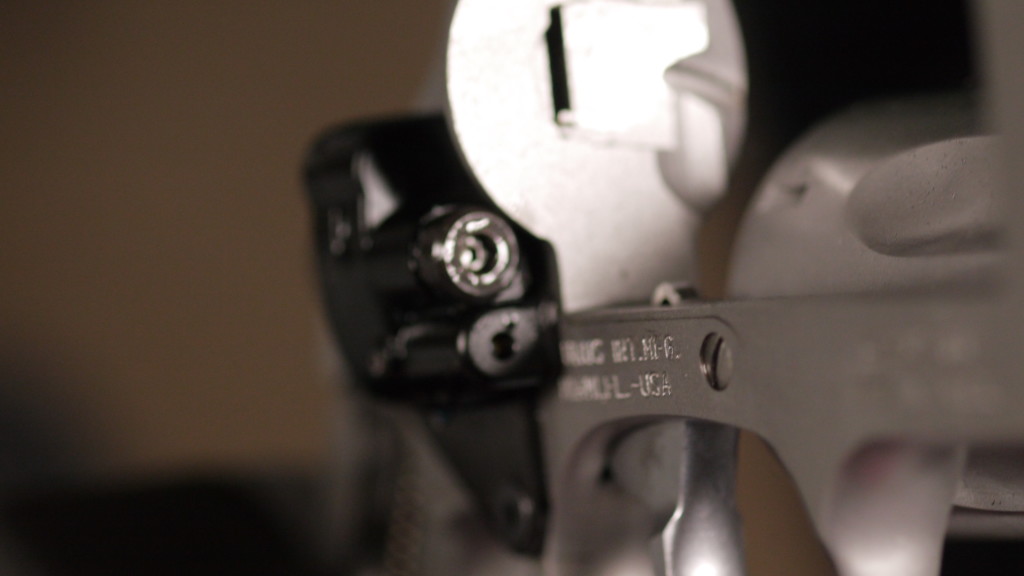A laser. On a Judge. Really?
Okay, let me explain…
Um… yeah, I don’t really have a good explanation. All right, here’s the deal – I do agree that a laser on a defensive weapon may not be the best idea, because you never want to depend on something that may have a dead battery when you need it most. I understand that, and I agree with it. But with that said, let me also add — not all of us are blessed with perfect vision, and sometimes we could use a little help. I had Lasik eye surgery, for example, and now I can see crystal-clear to infinity, but — up close, my closest focus position is about a foot past how far I can hold my arm out.
In other words, in low light conditions, unless I’ve got reading glasses on, I can’t focus on the front sight. And as any shooter with experience will tell you, for best results, you want to focus on the front sight.
In daylight I can see it fine. In daylight the eye’s iris closes down and (if you know photography you’ll know this) the smaller the iris, the deeper the depth of field, meaning that you can focus closer and further than at night. And in daylight, the Judge’s excellent fiber-optic sight glows and is in sharp focus. But on a darker indoor shooting range, where the fiber-optic isn’t glowing, well… yeah, I struggled with seeing the front sight.
And besides, lasers are cool and I wanted one. Okay, yeah, I said it — it’s a LASER. That’s pretty cool. Of course, you could tape a $10 laser pointer on top of your Public Defender and that’s also a laser, but — yeah, that’s not cool. At all.
And finally — no, you don’t want to rely on a laser when the chips are down and the bullets start flying, but — it certainly can’t hurt to have it, right? To be sure, you MUST train without the laser, you must be able to shoot straight and hit what you’re aiming at without the use of an additional, battery-dependent, potentially-failing electronic device. So as long as you’ve trained that way, what would it hurt to have a laser too? In addition? The way I see it, more options just makes you better off.
Finally, some people might say “but a Judge is the LAST gun that needs a laser! It’s a shotgun, just point it in the general direction and pull the trigger!” But those people would be wrong. Shotguns need to be aimed too! And if you’re using a good powerful defensive round in your Judge, it’s not going to spread out very far, so you want good aim. Birdshot may spray everywhere in a big pattern, but birdshot won’t stop an attacker. Buckshot will, and .45 Colt loads will, and buckshot doesn’t spread more than a few inches at personal-defense distances (typically 7 yards or less). So yes, you do have to aim, just like with any other pistol (or rifle or shotgun).
So seeing as I was having difficulty seeing the sights in darker conditions, I thought — wonder if a laser would be any real help? And googling around, I found LaserLyte was basically the only manufacturer who makes a laser that will fit the Judge Public Defender. I have the steel model, and the LaserLyte CK-SWAT fits it (and other pistols, like the Smith & Wesson J-frames and other Taurus revolvers, although it will NOT fit on the polymer Public Defender).
I found it for a decent price on Amazon, bought it, and installed it. Installation was actually really simple. First step, remove the grip off your Public Defender — that’s one allen screw and then it slips right off.
Unpacking the LaserLyte packaging you’ll find the laser itself mounted to a mounting plate, and a couple of additional mounting plates. I had to remove the laser from the included S&W plate and install it on the appropriate Taurus plate, which was a matter of two little allen-head screws. After that, remove a couple of screws from the frame, and attach the mounting plate into the screw-holes, and you’re up and running.
Here’s the laser ready to be installed:
The picture above is with the laser installed on the Public Defender. It’s really quite tiny and totally unobtrusive. It doesn’t interfere with the grip in any way, and you basically don’t even know it’s there unless you turn it on.
Once you have the laser installed and reattached your pistol’s grip, it’s time to aim it. Aiming the laser is pretty straightforward, there are two included tiny allen wrenches, one for the windage (left-right) and one for elevation (up/down). Yes, the windage and elevation screws are different sizes and require different wrenches; that’s silly, but it’s the way it is. Anyway, secure your Judge somehow (I have a CTK Precision Ultimate Gun Vise for these types of jobs) and put up a target or crosshairs at 21 feet from the muzzle (the CK-SWAT is designed to be “zero’d” at 21 feet). Then just adjust the allen screws to move the laser’s dot to coincide with your gun’s sights and you’re ready to go to the range and zero it in. Just make sure that your last adjustment is clockwise, as that’s what tells the screws to lock in and hold position.
Zeroing in was quite necessary because, as I found, I’m actually a better shot with the Judge than I’d previously thought — it turns out that my front sight is just a little bit off to the right, so those missed bullseyes weren’t entirely my fault! I’ve since had the gun’s front sight adjusted, so now with the sights or with the laser I can hit point of aim and deliver nicely tight groups at defensive distances. I’ve put a few hundred rounds through the Judge with the laser installed and haven’t noticed it losing “zero” at all.
The laser’s great to have at night or in darker conditions, because in those scenarios it’s really very obvious what you’re aiming at. And you don’t have to have a perfect stance with the gun drawn level to your eye; pretty much if you put the red dot on the target and pull the trigger, there’ll be a hole there. It works well for that purpose.
In daylight, it’s nigh unto useless. I mean, you can actually make out the dot at up to maybe 15 feet away, but it’s not easy. You really have to be looking for it. A green laser would be vastly preferable for daylight use; As an example, for rifles I picked up an inexpensive green laser from Primary Arms that is easily and clearly visible to 100 yards even in the daylight, but the CK-SWAT isn’t a green laser, it’s a red laser, and a red laser in daylight is only good for maybe 15 feet or so. Which isn’t really a problem, because in daylight you can rely on the Judge’s excellent fiber-optic sight; the laser performs best in scenarios where the gun’s own sights fall short, which is convenient.
Operationally, there’s not a lot to it. Press the button to turn it on, and it glows steady. Hold the button in, and it’ll strobe on/off. Press it again to turn it off — or, if you forget to turn it off, it’ll turn itself off after a few minutes. That’s really a nice feature, because replacing the batteries is NOT very fun at all. It takes four tiny batteries, and you need an allen wrench to open the battery cover, and then you have to pound the pistol into your hand to shake the batteries loose, and getting that fourth battery out is a bugger. I’ve done it a couple of times since getting the laser, and each time it’s been the same: the first two will pop right out, the third one’s a fight, and getting that fourth one out is like trying to reason with a teenage daughter. It can be done but it takes a lot of effort.
The operational drawback to the LaserLyte is that you have to manually turn the laser on. I mean, duh, right, but stick with me for a second — Crimson Trace rules the laser roost with their instinctive grip system; I have a Crimson Trace on another pistol and the on/off switch is incorporated to the grip — it’s instinctive, and it’s brilliant. Basically if you pick up the pistol in a shooting grip, the laser will already be on. That’s fantastic — but that’s Crimson Trace, not LaserLyte (or anyone else). With LaserLyte you have to manually turn the laser on. Is that a big deal? Obviously not, if you have the time to do it (say, you hear a bump in the night so you grab your nightstand gun, and turn on the laser). In that scenario, it’s no problem. But if you’re out in public and a mugger pulls a gun on you and you have to react instantly, you’re not going to stop and turn on the laser! So in that scenario, you’re not going to have the benefit of the laser. But, to be fair again, I’ve heard it said that scenarios like that usually involve “3-3-3: they take place at 3 feet, they last for 3 seconds, and there’s usually 3 rounds fired.” And in a scenario like that a laser wouldn’t do you any good anyway.
A word about customer service – on my first LaserLyte, I aimed it as best I could, but the point of impact was a quite a bit higher and several inches to the left of where I could get the laser to reach. No matter how much I adjusted it, I couldn’t get it to close enough to the exact point of impact. I contacted LaserLyte, and they told me about the “reset” procedure (backing out the adjustment screws all the way and leaving it that way for a certain amount of time). After doing that, I was able to get the windage spot-on, but I couldn’t get the elevation exactly right — it was still an inch or two lower than the actual point of impact. To tell you the truth, I actually didn’t care all that much, I figured a couple of inches is no big deal over the course of 21 feet, I can easily compensate for that, but LaserLyte wasn’t happy with that. They immediately arranged not only a replacement, which they cross-shipped to me (meaning, they sent the new one and let me install it before returning the old one), but they also included a package of replacement batteries as a gift. Now, that was some first-class service and I was very pleased by their response. The new laser works very well, and I can say that I get some variation in the point of impact based on which particular ammo I’m using (which is to be expected, of course), but with the right stuff I can make a hole exactly where the laser is pointing, and it’s hard to ask for much more than that.
Summation: the LaserLyte CK-SWAT is a good product that does what it says it will. Is it worth the money? Well, it’s not a lot of money, it’s about half the cost of a comparable Crimson Trace, and Crimson Trace doesn’t make one that fits the Public Defender anyway, so … it’s not that much money, and you do get a workable, usable laser. But could that money be spent elsewhere on better upgrades? Maybe. I’m not so sure I’d do it again if I had it all to do over again; maybe investing in some glow-in-the-dark night sights would be a better way to spend that money. The laser’s cool and all, but having to take a separate step to turn it on does limit its immediate functionality. However, I can guarantee you that if there was a bump in the night, I’ll be pretty happy to press that button.
Overall, I say that if you really want a laser for your Judge, the CK-SWAT does work and works well. I have no complaints about it. I just wish it was integrated like the Crimson Trace product line is.





